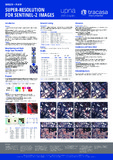Mostrar el registro sencillo del ítem
Super-resolution for Sentinel-2 images
| dc.creator | Galar Idoate, Mikel | es_ES |
| dc.creator | Sesma Redín, Rubén | es_ES |
| dc.creator | Ayala Lauroba, Christian | es_ES |
| dc.creator | Aranda, Carlos | es_ES |
| dc.date.accessioned | 2020-05-19T06:57:57Z | |
| dc.date.available | 2020-05-19T06:57:57Z | |
| dc.date.issued | 2019 | |
| dc.identifier.issn | 1682-1750 | |
| dc.identifier.uri | https://hdl.handle.net/2454/36919 | |
| dc.description | Trabajo presentado al PIA19+MRSS19 – Photogrammetric Image Analysis & Munich Remote Sensing Symposium, 2019, Munich | es_ES |
| dc.description | Incluye póster | es |
| dc.description.abstract | Obtaining Sentinel-2 imagery of higher spatial resolution than the native bands while ensuring that output imagery preserves the original radiometry has become a key issue since the deployment of Sentinel-2 satellites. Several studies have been carried out on the upsampling of 20m and 60m Sentinel-2 bands to 10 meters resolution taking advantage of 10m bands. However, how to super-resolve 10m bands to higher resolutions is still an open problem. Recently, deep learning-based techniques has become a de facto standard for single-image super-resolution. The problem is that neural network learning for super-resolution requires image pairs at both the original resolution (10m in Sentinel-2) and the target resolution (e.g., 5m or 2.5m). Since there is no way to obtain higher resolution images for Sentinel-2, we propose to consider images from others sensors having the greatest similarity in terms of spectral bands, which will be appropriately pre-processed. These images, together with Sentinel-2 images, will form our training set. We carry out several experiments using state-of-the-art Convolutional Neural Networks for single-image super-resolution showing that this methodology is a first step toward greater spatial resolution of Sentinel-2 images. | en |
| dc.format.extent | 8 p. | |
| dc.format.mimetype | application/pdf | en |
| dc.language.iso | eng | en |
| dc.publisher | International Society for Photogrammetry and Remote Sensing | en |
| dc.relation.ispartof | International Archives of The Photogrammetry, Remote Sensing and Spatial Information Sciences - ISPRS Archives, 2019, XLII-2/W16, 95-102 | en |
| dc.rights | © Authors 2019. Creative Commons Attribution 4.0 International (CC BY 4.0) | en |
| dc.rights.uri | http://creativecommons.org/licenses/by/4.0/ | |
| dc.subject | Super-resolution | en |
| dc.subject | Deep learning | en |
| dc.subject | Sentinel-2 | en |
| dc.subject | Image enhancement | en |
| dc.subject | Convolutional neural network | en |
| dc.subject | Optical images | en |
| dc.title | Super-resolution for Sentinel-2 images | en |
| dc.type | info:eu-repo/semantics/conferenceObject | en |
| dc.type | Contribución a congreso / Biltzarrerako ekarpena | es |
| dc.contributor.department | Institute of Smart Cities - ISC | es_ES |
| dc.rights.accessRights | info:eu-repo/semantics/openAccess | en |
| dc.rights.accessRights | Acceso abierto / Sarbide irekia | es |
| dc.identifier.doi | 10.5194/isprs-archives-XLII-2-W16-95-2019 | |
| dc.relation.publisherversion | https://doi.org/10.5194/isprs-archives-XLII-2-W16-95-2019 | |
| dc.type.version | info:eu-repo/semantics/publishedVersion | en |
| dc.type.version | Versión publicada / Argitaratu den bertsioa | es |




